
Real-time processing with the Philips LPC ARM mcu using GCC and uCOS II RTOS (D.W. Hawkins, 2006)
.pdf
AR1803 |
May 10, 2006 |
4.1.1Port header; os cpu.h
Critical section protection
The ARM-GCC port uses OS critical section protection method #3; it defines a function for saving the processor status while disabling FIQ and IRQ interrupts, and another to restore the processor status. The function declarations and critical section macros are located in os_cpu.h;
OS_CPU_SR OS_CPU_SR_Save(void);
void OS_CPU_SR_Restore(OS_CPU_SR cpu_sr);
#define OS_ENTER_CRITICAL() {cpu_sr = OS_CPU_SR_Save();} #define OS_EXIT_CRITICAL() {OS_CPU_SR_Restore(cpu_sr);}
and the function implementations are in os_cpu_a.s. The implementation of the OS_CPU_Save_SR() function is based on the recommendations in Atmel’s ARM processor application note Disabling Interrupts at Processor Level [4].
Task-level context switch
The task-level context switch macro, OS_TASK_SW(), is defined as a call to OSCtxSw() (see the
OS_CPU_A.ASM section.
4.1.2Port C-functions; os cpu c.c
The only C function the port needed to define was OSTaskStkInit() to initialize the stack as shown in Figure 11.
4.1.3Port assembler-functions; os cpu a.s
A port requires the implementation of OSCtxSw (task-level context switch), (time-tick ISR).
four assembler routines; OSStartHighRdy (start multi-tasking), OSIntCtxSw (interrupt-level context switch), and OSTickISR
Start multi-tasking
OSStartHighRdy() is called at the end of OSStart() (in µCOS-II source file OS_CORE.C), and is the exit point from main()’s context into the RTOS. OSStartHighRdy() implements the context restore of the registers shown in Figure 11. The function starts by ensuring that the processor is in user/system mode with FIQ and IRQ interrupts disabled (although having the interrupts disabled is not critical, as there should be no interrupt generating sources setup at this point). The OSTaskSwHook() function is then called, and the OSRunning flag set to true. The user/system mode stack pointer is then changed to that of the highest-priority (and only) task. The task CPSR is then copied into the CPSR register (which happens to enable FIQ/IRQ interrupts), and the task register context is restored.
Task-level context switch
OS_Sched() (OS_CORE.C) calls OS_TASK_SW() to implement a task-level context switch from inside a critical section (so both FIQ and IRQ are disabled when this function is called). The macro OS_TASK_SW() is a call to OSCtxSw() in this port, so on entry to the context switch function, the link register will contain the task return address. The job of OSCtxSw() is to save the current task context, switch over to the higher-priority task, and then restore context. The code saves the current tasks registers onto its stack as shown in Figure 11; the contents of link register is saved to both the link register and the program counter locations on the stack. The task stack-pointer is then saved to its task control block, the OSTaskSwHook() function is called, the higher-priority task stack is loaded, and the context of the higher-priority task is restored.
41

AR1803 |
May 10, 2006 |
Interrupt-level context switch
The FIQ and IRQ ISRs start by saving the processor context, incrementing the OSIntNesting counter (and saving the current value of the stack pointer if required), and the IRQ ISR then reenables IRQ interrupts. The ISR then calls handler code (written in C). When the handler returns, the ISR calls OSIntExit(), and then restores the processor state.
OSIntExit() (OS_CORE.C) checks to see if interrupt nesting is over, and then if a higherpriority task is ready. If interrupts are still nested, or the same task has the highest priority, then OSIntExit() returns, and the ISR runs to completion (i.e., performs the context restore of the task or interrupt it interrupted). If however, interrupt nesting is over, and a higher-priority task has been made ready, then a switch to the new task is required; that is the job of OSIntCtxSw(). OSIntExit() calls OSIntCtxSw() inside a critical section, so interrupts are disabled when this function is called.
The interrupt-level context switch code is similar to the task-level context switch code, except that the ISR has already done the work of saving the processor context to the task stack. OSIntCtxSw() starts by calling the OSTaskSwHook(), the higher-priority task stack is then loaded, and the context of the higher-priority task is restored.
Interrupt service routines (ISRs)
The FIQ and IRQ ISRs are setup to call C-coded handlers. It is up to the board-support package to decide where to call the OS function OSTimeTick(). For example, timer 0 can be setup to generate clock ticks and the VIC can be setup to generate an FIQ (for testing), or as an IRQ (a vectored interrupt would be recommended).
When an FIQ interrupt occurs, the ISR performs a partial context save (since the stack pointer is currently that of the FIQ, not the system mode task stack), and the processor is placed into system mode with interrupts disabled. The task context is then saved to the task stack. The interrupt nesting counter is then incremented, and if this is the first layer of nesting, the current value of the stack-pointer is saved to the task control block. The processor is then changed back to FIQ mode with interrupts disabled, and the FIQ handler function is called. After the handler returns, the processor is moved back to system mode, OSIntExit() is called, and the task context is restored. FIQ interrupts are not nested.
When an IRQ interrupt occurs, the ISR performs a partial context save (since the stack pointer is currently that of the IRQ, not the system mode task stack), and the processor is placed into system mode with interrupts disabled. The task context is then saved to the task stack. The interrupt nesting counter is then incremented, and if this is the first layer of nesting, the current value of the stack-pointer is saved to the task control block. The VIC vector address register is then read. The VIC vector address register returns the address of the IRQ handler, and triggers the VIC priority logic to only allow IRQ interrupts of higher-priority to interrupt the processor core. FIQ and IRQ interrupts are then enabled (with the processor left in system mode), and the handler function read from the VIC is called. After the handler returns, FIQ and IRQ interrupts are disabled, and the VIC is acknowledged by writing to the VIC vector address register. OSIntExit() is called, and the task context is restored.
4.1.4Board-support package; BSP.H,.C
The port assembly language file os_cpu_a.s defines an FIQ interrupt service routine that calls a C-coded handler; that handler needs to be supplied as part of the board-support package, or the function needs to be defined in the user application. The minimal form of the handler is;
void OS_CPU_FIQ_ISR_Handler(void)
{
return;
}
42
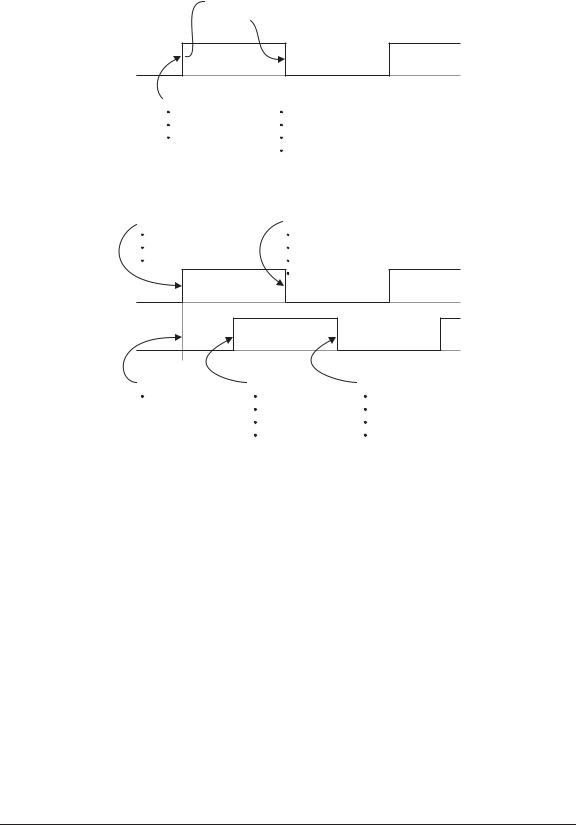
AR1803 |
May 10, 2006 |
 ISR
ISR
 posts semaphore
posts semaphore
Task |
Task |
sets I/O pin high |
pend completes |
sets EINT bit |
sets I/O pin low |
pends on semaphore |
sets EINT bit |
|
pends on semaphore |
|
(a) |
Task A |
Task A |
sets I/O pin high |
pend completes |
posts semaphore A |
sets I/O pin low |
pends on semaphore B |
posts semaphore A |
|
pends on semaphore B |
Task B |
Task B |
Task B |
pends on semaphore A |
pend completes |
pend completes |
|
sets I/O pin high |
sets I/O pin low |
|
posts semaphore B |
posts semaphore B |
|
pends on semaphore A |
pends on semaphore A |
(b)
Figure 12: µCOS-II ARM port testing. (a) task-to-ISR context switching, and (b) task-to-task context switching.
The port of the AN-1011 code requires a similar function defined for the IRQ ISR handler. The port described by this document accesses the IRQ ISR from the VIC vector address register, so does not require linking with an IRQ handler function. The BSP should also contain an initialization routine to setup a timer that generates an FIQ or IRQ interrupt, and a corresponding handler that calls the
OSTimeTick() routine.
The example programs supplied with this document contain a minimal board support package containing timer setup, and LED control functions.
4.2Port testing
This section presents test results from the AN-1011 ARM µCOS-II port and the ARM nestedinterrupts version presented in this document.
4.2.1Test 1: Task-to-IRQ context switching
Figure 12(a) shows the sequence of a task-to-ISR test. A test application was written containing a single task, and an interrupt handler for EINT0. The task sets an I/O pin high, triggers an EINT0
43

AR1803 |
May 10, 2006 |
interrupt, then pends on a semaphore. The interrupt handler posts a semaphore (an I/O pin is toggled while in the ISR). The task receives the semaphore, sets an I/O pinlow, triggers an EINT0 interrupt, then pends on a semaphore. This sequence is repeated in a while loop.
Figure 13 shows the results of the task-to-ISR context switch testing for two ARM ports.
The time between the rising edge of the tasks LED to that of the ISR handler is 3.5µs for the AN-1011 port, and 2.7µs for the nested interrupts port (due to its use of load/store multiple instructions). The total task-to-ISR-to-task time is 13.0 andµs 11.7µs. Both ports can perform approximately 40,000 context switches per second.
4.2.2Test 2: Task-to-task context switching
Figure 12(b) shows the sequence of a task-to-task test. A test application was written containing two tasks, task A and task B. Task A posts semaphore A and then pends on semaphore B. Task B does the opposite, it pends on semaphore A, and posts semaphore B.
When Task A pends on semaphore B, it gives up the processor, and causes a task-level context switch to task B (task B is now ready, since task A posted the semaphore it was waiting for). The time between the rising-edge of the I/O pin toggled by task A, to the rising-edge of the I/O pin toggled by task B, is the time taken for a task-to-task context switch. Figure 14 shows the results of the task-to-task context switch testing for two ARM ports. The rising-edge to rising-edge time is about 13µ, and both square waves have a frequency of around 20kHz, i.e., around 40,000 context switches per second occur.
4.2.3Test 3: IRQ-FIQ interrupt nesting
Figure 15 demonstrates the IRQ nesting feature of the port presented in this document relative to the AN-1011 port. A task triggers an EINT1 IRQ interrupt which triggers a higher priority EINT0 FIQ interrupt. In Figure 15(a) the EINT1 handler finishes before the higher-priority EINT0 handler, as the AN-1011 port does not implement IRQ-FIQ interrupt nesting. However, in Figure 15(b) the EINT1 handler is interrupted by the EINT0 handler.
4.2.4Test 4: IRQ interrupt nesting
Figure 16 demonstrates the IRQ nesting feature of the port presented in this document relative to the AN-1011 port. A task triggers an EINT1 interrupt which triggers a higher priority EINT0 interrupt. In Figure 16(a) the EINT1 handler finishes before the higher-priority EINT0 handler, as the AN-1011 port does not implement interrupt nesting. However, in Figure 16(b) the EINT1 handler is interrupted by the EINT0 handler.
44
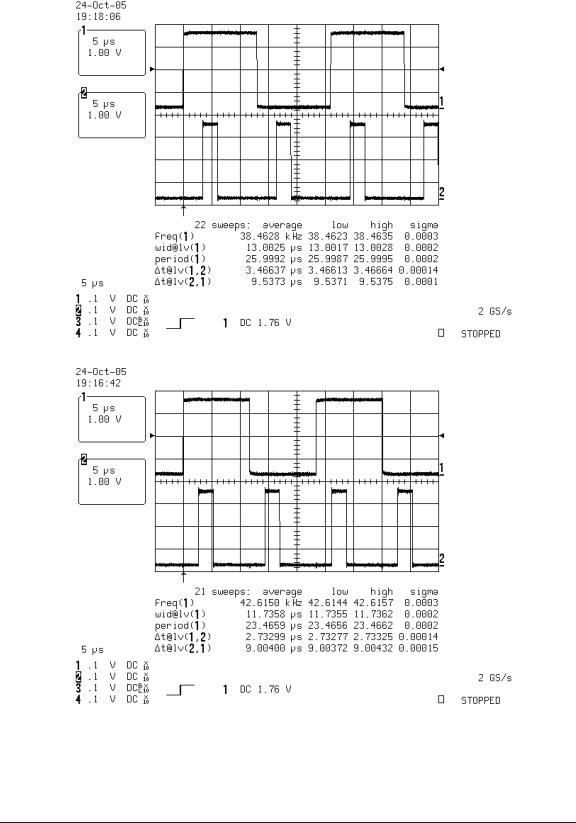
AR1803 |
May 10, 2006 |
(a)
(b)
Figure 13: µCOS-II ARM task-to-ISR context switch testing; (a) for AN-1011 port, and (b) the nested interrupts port.
45
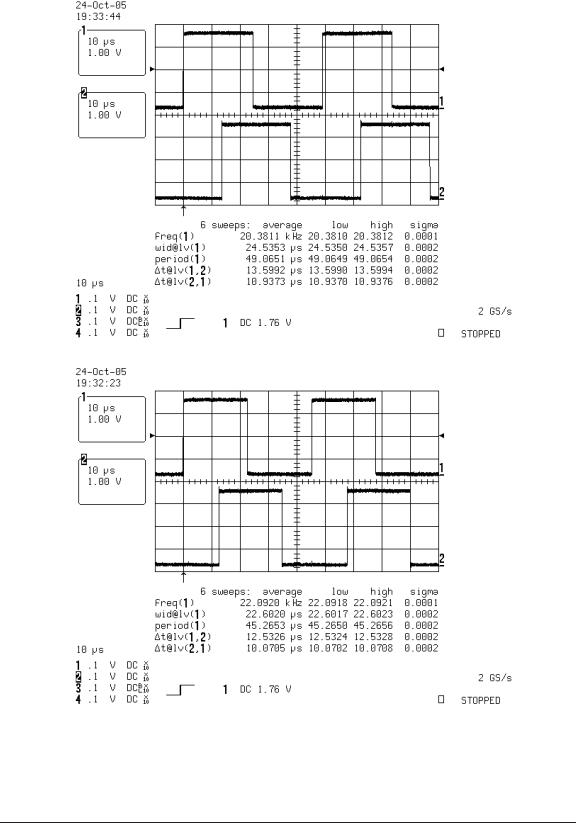
AR1803 |
May 10, 2006 |
(a)
(b)
Figure 14: µCOS-II ARM task-to-task context switch testing; (a) for AN-1011 port, and (b) the nested interrupts port.
46
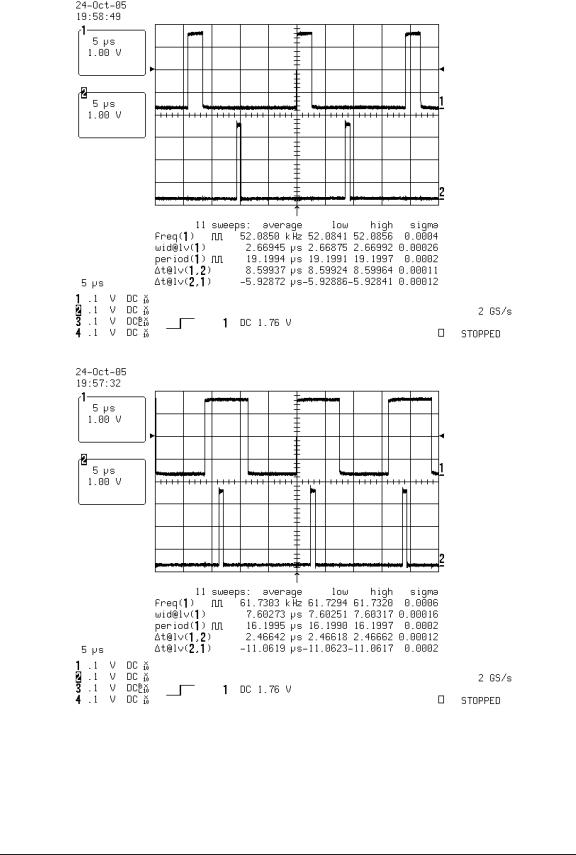
AR1803 |
May 10, 2006 |
(a)
(b)
Figure 15: µCOS-II ARM IRQ-FIQ nesting testing; a task triggers an EINT1 IRQ interrupt which triggers a higher priority EINT0 FIQ interrupt. The top trace is an I/O pulsed in the EINT1 handler, while the bottom trace is the EINT0 handler. Figure shows the waveform (a) for the AN-1011 port, and (b) for the nested interrupts port. Note that in (a) the EINT1 IRQ handler finishes before the higher-priority EINT0 FIQ handler, as the AN-1011 port does not implement IRQ-FIQ interrupt nesting.
47
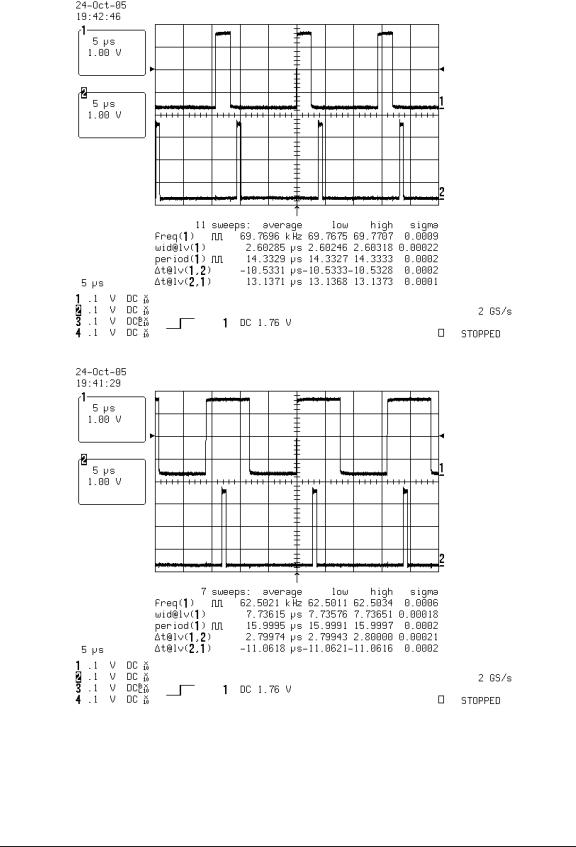
AR1803 |
May 10, 2006 |
(a)
(b)
Figure 16: µCOS-II ARM IRQ nesting testing; a task triggers an EINT1 interrupt which triggers a higher priority EINT0 interrupt. The top trace is an I/O pulsed in the EINT1 handler, while the bottom trace is the EINT0 handler. Figure shows the waveform (a) for the AN-1011 port, and (b) for the nested interrupts port. Note that in (a) the EINT1 handler finishes before the higher-priority EINT0 handler, as the AN-1011 port does not implement interrupt nesting.
48

AR1803 |
May 10, 2006 |
4.3uCOS-II examples
4.3.1Example 1: Blinking LEDs
The µCOS-II example 1 program creates two tasks. Each task controls four LEDs. The first task rotates its four LEDs every 1s, while the second task rotates its LEDs every 250ms. The delays are implemented using OS delay functions.
4.3.2Example 2: Serial port echo console
The µCOS-II example 1 program creates a task that listens on a serial port and echos what is typed, and another task that blinks LEDs.
Download the program (eg. using FlashUtils), and connect to the other serial port on the board 115200-baud, and you will be greeted with the following message;
-----------------------------------
Welcome to uCOS-II!
-----------------------------------
This application will echo characters received. When a line of text is received on the serial port,
one of four LEDs (LED[0:3]) is blinked on the MCB2130.
A second task rotates the other four LEDs (LED[4:7]) every 250ms.
uCOS-II>
The serial port driver included with the example is interrupt driven and uses the µCOS-II OS to cause the task controlling the serial port to block appropriately.
I’d like to explain in mode detail, but I have simply run out of time, its now time to upload this entry!
49

AR1803 |
May 10, 2006 |
A ARM GCC
The GNUARM web site www.gnuarm.com contains pre-built binaries of the GCC compiler for ARM systems. The tools used at the time of writing of this document consisted of;
•binutils-2.15.tar.bz2
•newlib-1.12.0.tar.gz
•gcc-3.4.3.tar.bz2
•insight-6.1.tar.gz
The GNUARM binary tools can be used directly, or you can build them via the following instructions. Building the tools yourself is useful if you also want to build for other CPU architectures.
A.1 Build procedure
The tools in this section were built in July 2005 under Cygwin on a Windows 2000 machine, and under Linux on a Red Hat 9.0 machine. Cygwin used gcc 3.4.4, while Linux used the default Red Hat gcc 3.2.2. The machine was a dual-boot HP Omnibook 6100 laptop (1GHz Pentium III-M with 512MB RAM).
Building binutils under Cygwin and Linux (bash shell syntax):
1.export TARGET=arm-elf
2.export PREFIX=/opt/gnutools
3.tar -jxvf binutils-2.15.tar.bz2
4.mkdir binutils-build; cd binutils-build
5. ../binutils-2.15/configure --target=$TARGET --prefix=$PREFIX --enable-interwork --enable-multilib
6.make
7.make install (requires logging in as root under Linux)
Note: the first time I attempted to build binutils under Cygwin, it failed, as it could not find lex. So, be prepared to update and add tools to your Cygwin installation.
Building gcc and newlib under Cygwin and Linux:
1.export TARGET=arm-elf
2.export PREFIX=/opt/gnutools
3.export PATH=$PREFIX/bin:$PATH
4.tar -jxvf gcc-3.4.3.tar.bz2
5.tar -zxvf newlib-1.12.0.tar.gz
6.cp t-arm-elf gcc-3.4.3/gcc/config/arm/
(this updated file is from the GNUARM site and sets up the multilib build)
50
